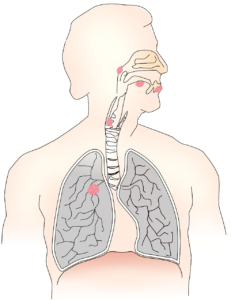
If the thought of RMST, IMST, and EMST leaves you breathless and your head spinning, have no fear. This basic primer will demystify the intervention and clear the air.
Respiration, phonation, and swallowing go hand in hand (and in hand). With overlapping systems and functions (Coyle 2010), think of them in an intricate dance where timing is everything. When something interrupts this dance, say neuro-degenerative disease for example, the systems become unbalanced and disordered.
Respiratory Muscle Strength Training (RMST) is used to address respiratory compromise. Respiration, or the exchanging of carbon dioxide and oxygen (Sapienza & Troche 2012), is not to be confused with ventilation, which is simply moving air in and out of the lungs (Rhodes and Martin 2019a). It’s important to note that modern medicine can move air in and out of anyone’s lungs (i.e. ventilator), but it cannot force the exchanging of gases.

The goal of RMST is to increase the force generating capacity of the inspiratory and expiratory respiration muscles. Stronger muscles increase efficiency with respiration, phonation, and swallowing, facilitating a return to the delicate balance between the systems (Troche 2015). RMST is broken into two categories: IMST and EMST.
Inspiratory Muscle Strength Training (IMST) focuses on the muscles of inspiration: diaphragm and external intercostals. Indications for IMST include poor ability to draw in adequate air into the lungs for subsequent gas exchange. IMST strengthens the diaphragm, improves vocal fold movement patterns, and assists with vent weaning (Troche 2015).
Expiratory Muscle Strength Training (EMST) focuses on the muscles of expiration: abdominal muscles and internal intercostals. Indications for EMST include weak cough, compromised airway protection, and decreased vocal intensity. EMST improves cough function, airway protection, assists with vent weaning, and increases maximum expiratory pressure (Troche 2015). Refer to the table below for a summary.
Respiratory Muscle Strength Training summarized+
| IMST | EMST | |
| Purpose | Strengthening respiratory musculature to increase ability to fill lungs using neuromusclular plasticity principles of intensity, repetition, overload, specificity, saliency and transference | Strengthening respiratory musculature associated with cough, swallowing, and vocal function using neuromusclular plasticity principles of intensity, repetition, overload, specificity, saliency and transference |
| Indications | Weakened diaphragm, vocal fold dysfunction, decreased maximum inspiratory pressure | Decreased cough strength/efficiency, impaired airway protection, reduced vocal intensity |
| Targeted Muscles | Diaphragm, external intercostals | Abdominal muscles, internal intercostals |
| Targeted Impairments | Diaphragm function, vocal fold movement patterns, mechanical ventilation weaning | Cough function, airway clearance, vocal function, and mechanical ventilation weaning |
| Potential Populations* | Cardiopulmonary Disease Cerebrovascular Accident (CVA) Chronic Obstructive Pulmonary Disease (COPD) Congestive Heart Failure (CHF) Cystic Fibrosis (CF) Diaphragm Paresis/Paralysis Dysarthria Dysphonia Huntingon’s Disease Multiple Sclerosis (MS) Myasthenia Gravis (MG) Paradoxical Vocal Fold Motion Dysfunction (PVFM) Parkinson’s Disease Progressive Supranuclear Palsy Spinal Cord Injury Vocal Cord Dysfunction (VCD) | Amyothrophic Lateral Sclerosis (ALS) Chronic Obstructive Pulmonary Disease (COPD) Cerebrovascular Accident (CVA) Dysarthria Dysphonia Head and Neck Cancer Huntington’s Disease Multiple Sclerosis (MS) Myotonic Dystrophy Parkinson’s Disease Progressive Supranuclear Palsy Spinal Cord Injury |
*Always consult the physician regarding concerns for patient appropriateness for RMST. This list is adapted from Sapienza & Troche 2012 and is not all inclusive of conditions that may benefit from RMST. + Rhodes, J., & Martin, A. (2019a).
Achieving the goals of RMST relies on measuring MIP and MEP. MIP refers to Maximum Inspiratory Pressure while MEP refers to Maximum Expiratory Pressure. Both measure the current strength of the targeted muscle group (inspiratory or expiratory) (Sapienza & Troche 2012). MIP and MEP can be determined using a peak flow meter (cost effective) or with a manometer (cost prohibitive). Pressure is measured in centimeters of water (cmH2O) or in liters of oxygen per minute (L O2/min) (Rhodes & Martin 2019b).
MIP and MEP can also be assessed using a pressure threshold device (i.e. EMST 150) by starting at the lowest resistance and incrementally increasing resistance until patient can perform one repetition max. This method is less precise compared to a peak flow meter, time consuming and potentially wasteful if the patient is unable to break the threshold at the minimum resistance or exceeds maximum resistance as these devices are single patient use (Rhodes & Martin 2019b).
Part two in the series will explore various types of devices, using a peak flow meter to determine a starting point for RMST, and contraindications for RMST.
References
- Coyle, J. (2010). Ventilation, Respiration, Pulmonary Diseases, and Swallowing . Perspectives on Swallowing and Swallowing Disorders (Dysphagia) 19(4), p 91-97
- Rhodes, J., & Martin, A. (2019a). Understanding Respiratory Muscle Strength Training ( RMST ): Part 1. Retrieved November 27, 2019, from https://medslpcollective.com/understanding-respiratory-muscle-strength-training-rmst-part-1-introduction/
- Rhodes, J., & Martin, A. (2019b). Understanding Respiratory Muscle Strength Training ( RMST ): Part 2 – Assessment Considerations. Retrieved November 27, 2019, from https://medslpcollective.com/understanding-respiratory-muscle-strength-training-rmst-part-2-assessment-considerations/
- Sapienza, C. & Troche, M. (2012). Respiratory Muscle Strength Training Theory and Practice. San Diego, CA: Plural Publishing Inc.
- Troche, M. S. (2015). Respiratory Muscle Strength Training for the Management of Airway Protective Deficits Is Incentive Spirometry a Means of Respiratory Muscle Strength Training ? How Can We Overload the Inspiratory and Expiratory Muscles? What Functional Outcomes Might Imp. 24(April), 58–64.

